Wednesday, 1 June 2011: Rain in Lyon
Written 3 June 2011
Not only did it rain Wednesday morning, but the weather snapped surprisingly cold and the wind whipped up. David slept so late (traditional on his first day in France but postponed this year in honor of CJ and Margaret) that I had to rescue his breakfast off the buffet when the dining room closed and bring it to him in the room. Although the room seats 30, we were clearly the only ones who bespoke breakfast—the large pastry basket contained exactly two croissants, two miniature pains au chocolat, two miniature pains au raisin, and a single baguette. The less perishable items were set out in slightly larger quantity—single-serve boxes of corn flakes, rice krispies, and cocoa krispies; a plate of dried apricots and prunes; tiny jars of orange marmelade, apricot jam, and orange-blossom honey; a chest of teabags. A cooler contained carafs of orange juice, grapefruit juice and milk; a large bottle of mineral water; a plate of cold-cuts; a bowl of fruit cocktail; single-serve packs of butter and Kiri (a spreadable breakfast cheese) and of applesauce and yogurt. A 10-channel automatic dispenser provided coffee and hot chocolate in a choice of strengths, as well as hot milk, hot water for tea. In addition a small espresso maker could be loaded with an assortment of cartridges. The only decaf coffee took the form of an espresso cartridge, so I usually use a large cup (rather than the little espresso cups provided on the buffet), make a "full cup" espresso into it, then move to the dispenser and top it up with hot milk—perfect café au lait.
Once David was finally upright, we shuffled through my collection of brochures and flyers, put on layers (we brought only our rain coats, without their fleece liners), and set off for the Office de Tourisme. The city has adopted the slogan "ONLY LYON," accompanied by its emblematic lion, and it has the slickest tourism arrangements I have ever encounted. For 41 euros each, we acquired three-day "city cards," which are a terrific deal—they confer free access to city-organized walking tours (we signed up for two on the spot); all public transportation (metro, trams, buses, funiculars), virtually all museums (all that we're interested in, plus many more, both public and private), and a river cruise (choice of two itineraries). Plus a 10% discount on merchandise in many stores. For a 1-euro supplement for each card, they're good for a free aperitif or coffee in any of many dozens of restaurants (as I write, we've tried that twice so far—Brasserie Georges disallowed it because David's glass of champagne did not fit their definition of "aperitif," which was limited to kir and beer, but the two supplementary euros had already repayed themselves at lunch, when Le Layon extended it to David's glass of red wine).
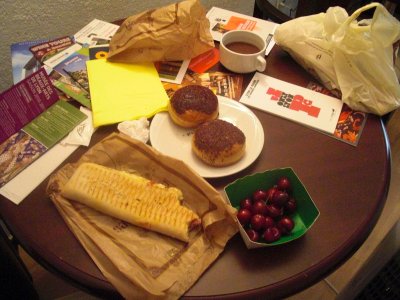 We walked back down rue Victor Hugo, a major pedestrian shopping street, toward our hotel, looking for lunch, but surprisingly, restaurants were sparse. It was still very cold and raining, so we finally stopped at a snack bar to get ourselves a couple of hot paninis and chocolate-filled doughtnuts and retired to our room. Here you see them on the table amid our litter of tourist literature , with the rest of my Paris cherries. The breakfast room was standing open, so David was even able to get a cup of hot chocolate. The doughnuts were really good!
We walked back down rue Victor Hugo, a major pedestrian shopping street, toward our hotel, looking for lunch, but surprisingly, restaurants were sparse. It was still very cold and raining, so we finally stopped at a snack bar to get ourselves a couple of hot paninis and chocolate-filled doughtnuts and retired to our room. Here you see them on the table amid our litter of tourist literature , with the rest of my Paris cherries. The breakfast room was standing open, so David was even able to get a cup of hot chocolate. The doughnuts were really good!
Back at the Office de Tourisme, we were surprised to find that 30 people showed up for the 2:30 p.m. walking tour of the old town, "Vieux Lyon." They were mostly our age and, so far as we could ascertain, were all French. In fact, Lyon is full of tourists, but most speak French, most of the rest Italian, and only a few English. But the tourism people, knowing so many had reserved, supplied two guides, so we split into two groups (ours included the middle-aged lady with the Yorkshire terrier in her handbag) and headed off to walk to the old town, across the Saône. (Lyon is located at the confluence of the Saône and the Rhône (although one tour guide told us that three rivers are said to flow into Lyon from the north, the Saône, the Rhône, and the Beaujolais) . Our hotel, the nearby Place Bellecour, the Office de Tourisme, and the Perrache train station are located on the peninsula, the narrow neck of land between the two rivers. Vieux Lyon, the original Roman settlements, the cathedral, the Fourvière hill, and its basilica are to the west, across the Saône. The newer part of the city, the airport, the "crayon," and the Part Dieu train station are to the east, across the Rhône. Fortunately, the rain stopped, so we didn't get too wet on the tour.
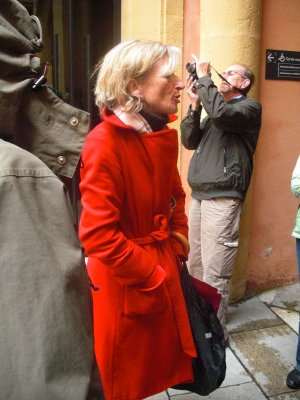
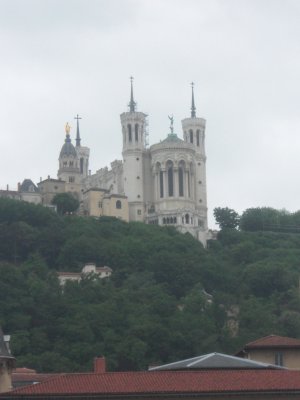 In the time just before and after the birth of Christ, Lyon (called Lugdunum) was the principal city of all of Gaul, with life closely modeled on that in Rome. The emperor Claude was actually borne here, because his father was a local dignitary in the Roman government. Romans, being Romans, always centered their settlements on the highest spot around, so they built the forum on top of the steep hill west of the Saône, now called "Fourvière" (from "forum vertus") (on the site now occupied by this ornate and stylistically eclectic basilica), then spread their improvements, dependencies, etc. around it down the sides of the hill. After the Roman era, though, the Lyonnais (in the late Middle Ages and early Renaissance) were river merchants, so they built right down on the banks of the Saône, on the very narrow strip of land between the water and the steep sides of the "Fourvière." Because river frontage was so valuable, the lots tended to be narrow and deep, so they built their storage buildings, gardens, etc. up the sides of the hill behind their houses. As a result, the official old city, for restoration and preservation purposes, is only three streets deep (measuring from the river) and a dozen blocks long. Space was at a premium because the town was very prosperous (the population was higher than it is today), so second and third houses were built in back yards, progressively up the hill, each several stories high. Exterior tower staircases were built that served more than one house—one directly and the other by means of an open gallery on each floor. Because of the tight packing and steep terrain, many buildings were connected to courtyards or the street by increasingly long, irregular, and twisting interior passages, some with stairs of their own, as they changed levels. Some connect street to street through rows of buildings. These passages are called "traboules" (from "transambulare," to walk through) and are still in use today. The Lyonnais have coined a verb "trabouler," to go someplace through a traboule.
In the time just before and after the birth of Christ, Lyon (called Lugdunum) was the principal city of all of Gaul, with life closely modeled on that in Rome. The emperor Claude was actually borne here, because his father was a local dignitary in the Roman government. Romans, being Romans, always centered their settlements on the highest spot around, so they built the forum on top of the steep hill west of the Saône, now called "Fourvière" (from "forum vertus") (on the site now occupied by this ornate and stylistically eclectic basilica), then spread their improvements, dependencies, etc. around it down the sides of the hill. After the Roman era, though, the Lyonnais (in the late Middle Ages and early Renaissance) were river merchants, so they built right down on the banks of the Saône, on the very narrow strip of land between the water and the steep sides of the "Fourvière." Because river frontage was so valuable, the lots tended to be narrow and deep, so they built their storage buildings, gardens, etc. up the sides of the hill behind their houses. As a result, the official old city, for restoration and preservation purposes, is only three streets deep (measuring from the river) and a dozen blocks long. Space was at a premium because the town was very prosperous (the population was higher than it is today), so second and third houses were built in back yards, progressively up the hill, each several stories high. Exterior tower staircases were built that served more than one house—one directly and the other by means of an open gallery on each floor. Because of the tight packing and steep terrain, many buildings were connected to courtyards or the street by increasingly long, irregular, and twisting interior passages, some with stairs of their own, as they changed levels. Some connect street to street through rows of buildings. These passages are called "traboules" (from "transambulare," to walk through) and are still in use today. The Lyonnais have coined a verb "trabouler," to go someplace through a traboule.
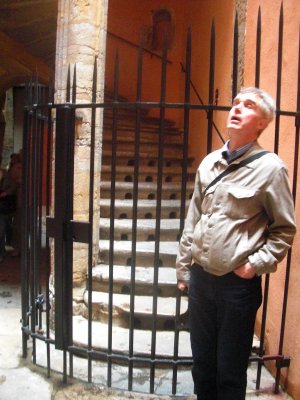 Our excellent guide (shown above in the red coat) emphasized that traboules are not public passageways; they are private and belong to the building owner or owners, so unless you live on one or know somebody, or the owner has an agreement with the city to keep one open for passage during the day, you wouldn't ordinarily use them, but the city guides have permission to take groups through, so we saw quite a lot of them, both in the old town and the following day on our tour of the Croix Rousse district. They were useful during the city's heyday as a silkweaving center (for getting bolts of silk from one building to another on rainy days), and they did yeoman service during WWII, when the resistance used them to move around the city unseen. Unless you know them very well, they are hard to find and easy to get lost in. Unfortunately, they're also difficult to photograph. In this photo, we're in a small courtyard, which we reached through one traboule and left through another. The risers of the stone treads of this staircase are pierced so that light can penetrate to illuminate the next flight of stairs below, which descend to the cellar. It's a design unique in Lyon and possibly everywhere.
Our excellent guide (shown above in the red coat) emphasized that traboules are not public passageways; they are private and belong to the building owner or owners, so unless you live on one or know somebody, or the owner has an agreement with the city to keep one open for passage during the day, you wouldn't ordinarily use them, but the city guides have permission to take groups through, so we saw quite a lot of them, both in the old town and the following day on our tour of the Croix Rousse district. They were useful during the city's heyday as a silkweaving center (for getting bolts of silk from one building to another on rainy days), and they did yeoman service during WWII, when the resistance used them to move around the city unseen. Unless you know them very well, they are hard to find and easy to get lost in. Unfortunately, they're also difficult to photograph. In this photo, we're in a small courtyard, which we reached through one traboule and left through another. The risers of the stone treads of this staircase are pierced so that light can penetrate to illuminate the next flight of stairs below, which descend to the cellar. It's a design unique in Lyon and possibly everywhere.
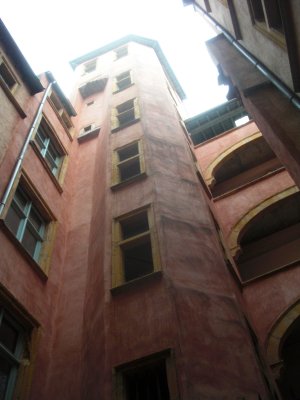
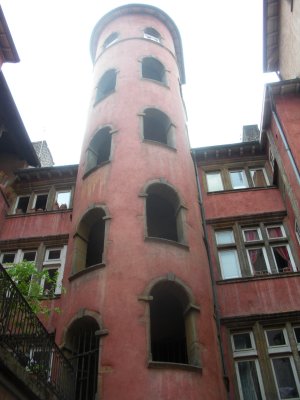 Here are a couple of the larger and better preserved staircase towers. Both are taller than necessary to house the staircases—a sign of wealth and prestige. The one on the right is the "tour rose," the tallest in the old town; that's its original color. Because the whole district is a national historical monument and world heritage site, restrictions on changing anything are very tight. The mullioned windows are a mark of renaissance architecture. The window frames are stone, but of a color that I keep mistaking for wood.
Here are a couple of the larger and better preserved staircase towers. Both are taller than necessary to house the staircases—a sign of wealth and prestige. The one on the right is the "tour rose," the tallest in the old town; that's its original color. Because the whole district is a national historical monument and world heritage site, restrictions on changing anything are very tight. The mullioned windows are a mark of renaissance architecture. The window frames are stone, but of a color that I keep mistaking for wood.
The old-town tour also included the cathedral of St. Jean (where Henri IV married Marie de Medici in the late 16th or early 17th century), which is actually on the river bank, at the foot of the hill. It's one of three churches along that stretch of the river (St. Georges, St. Jean, and St. Paul), each marking a village, and each village specializing in a certain set of trades. For example, I think the potters and weavers hung around St. Georges. Excavations preparatory to enlarging the Palais de Justice revealed ruins of at least two more churches, right next to the cathedral—the additions to the Palais de Justice were changed to raising its roof, and archeological studies are ongoing on the ruins. For me at least, the best part of the cathedral tour is the astronomical clock, which has been running continuously (and correctly!) since it was built in the 16th century. The tour was timed so that we could watch the action when it rang at 3 p.m.
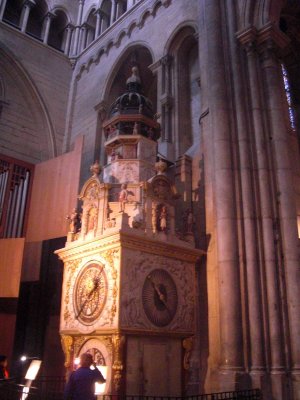
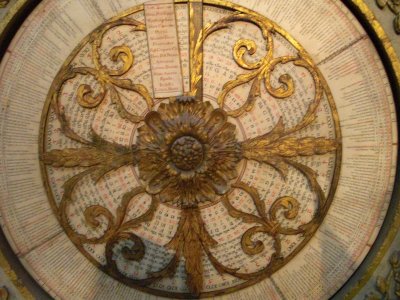 First, the bronze cock on the very top raises his head, flaps his wings, and crows twice (he sounds like a french horn). Twenty seconds later, the angel on the nearest corner (just above the level with the clock faces, begins turning this way and that and playing music (sounds like a celesta). A door opens next to the virgin Mary (on the highest light-colored level, below the dark-colored ones) and an archangel (Gabriel, I think) emerges. Then a little drap door over Mary's head opens, a tiny dove descends for a moment, then snaps back up into his cubby. Gabriel retires behind his door, and a priest, leaning out from the level just above Mary, waves his hand to bless her three times. Then the musical angel stops playing, the clock strikes the hour, and that's it until the next show. To conserve the mechanism, its keepers have set it to do the routine only four times a day rather than every hour.
First, the bronze cock on the very top raises his head, flaps his wings, and crows twice (he sounds like a french horn). Twenty seconds later, the angel on the nearest corner (just above the level with the clock faces, begins turning this way and that and playing music (sounds like a celesta). A door opens next to the virgin Mary (on the highest light-colored level, below the dark-colored ones) and an archangel (Gabriel, I think) emerges. Then a little drap door over Mary's head opens, a tiny dove descends for a moment, then snaps back up into his cubby. Gabriel retires behind his door, and a priest, leaning out from the level just above Mary, waves his hand to bless her three times. Then the musical angel stops playing, the clock strikes the hour, and that's it until the next show. To conserve the mechanism, its keepers have set it to do the routine only four times a day rather than every hour.
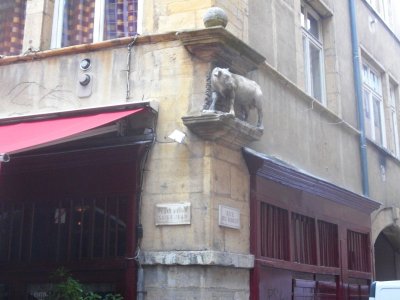 More interesting than the puppet show, though, is the the actual clock. The face shown here is the calendar. It tells the day, day of the week, month, and year (and yes, it knows all about leap years). The tall rectangular panel at the top of the photo lists the principal religious holidays and what day they fall on during the current year. The mechanism soldiers on indefinately, but the white dial with all the numbers and notations on it must be replaced every so often (some odd number of years; 59 maybe? you can figure it out by counting the number of entries in any given ring, toward the center of the dial) Anyway, this is the same dial that was in place when we visited in 1991, which has since rotated around to about the 4 o'clock position. It will have to be changed out for a new one in 2019. Other dials above and below this one and on other faces of the clock tell the phase of the moon, the zodiac sign, the hour, and the minutes.
More interesting than the puppet show, though, is the the actual clock. The face shown here is the calendar. It tells the day, day of the week, month, and year (and yes, it knows all about leap years). The tall rectangular panel at the top of the photo lists the principal religious holidays and what day they fall on during the current year. The mechanism soldiers on indefinately, but the white dial with all the numbers and notations on it must be replaced every so often (some odd number of years; 59 maybe? you can figure it out by counting the number of entries in any given ring, toward the center of the dial) Anyway, this is the same dial that was in place when we visited in 1991, which has since rotated around to about the 4 o'clock position. It will have to be changed out for a new one in 2019. Other dials above and below this one and on other faces of the clock tell the phase of the moon, the zodiac sign, the hour, and the minutes.
The tour ended in the old town (just a block or two from where this great stone ox serves as a street sign—for the illiterate population of years past—for the rue Boeuf, where the butchers had their shops), which is chock-a-block with quaint and authentic eateries, so we warmed up and rested our feet over a cup of tea in a nice Salon de Thé before walking home.
Dinner was at Le Mercère (a GM 13 in our Gault-Millau guide from two years ago; alas, this year we must bid farewell to the GM numerical grading system we have found so useful; with the current year's edition, they have switched to a system of one to five toques, i.e., chef's hats, and no numerical rating), so we took the metro one stop to Cordeliers, then walked west on rue Tupin to rue Mercière. We were seated next to a very nice couple from Australia, who were on a 9-week tour of Europe during his "periodical leave," a sort of sabbatical he gets every 10 years.
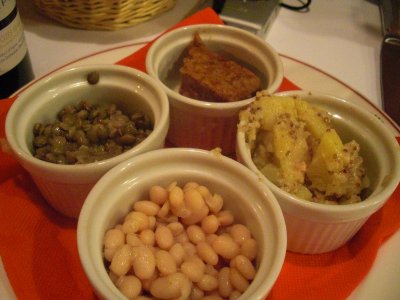
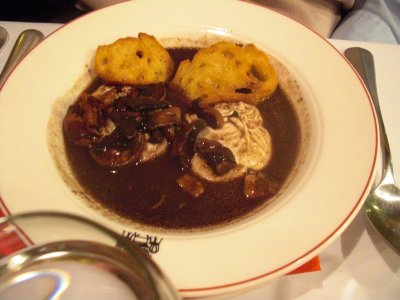 Amuse-bouche, both: Little round dishes of four Lyonnais specialties, clockwise from the top: rich, moist, coarse country-style pâpé; potato salad made with lots of coarse-grainedmustard and bits of soft garlic sausage; a salad of white beans with shallots; and lentils vinaigrette.
Amuse-bouche, both: Little round dishes of four Lyonnais specialties, clockwise from the top: rich, moist, coarse country-style pâpé; potato salad made with lots of coarse-grainedmustard and bits of soft garlic sausage; a salad of white beans with shallots; and lentils vinaigrette.
First course, David: Oeufs en meurette—soft-poached eggs in an amazingly rich and deep-flavored red-wine (in this case, specifically Morgon) sauce flavored with beef essence, mushrooms, and bacon bits. Two crisp-fried slices from a baguette. Best rendition of this dish we've ever had.
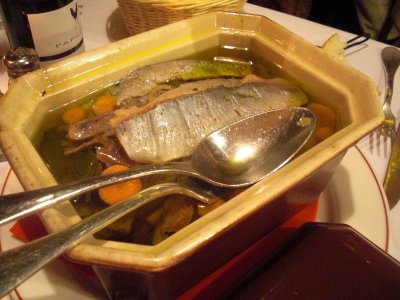
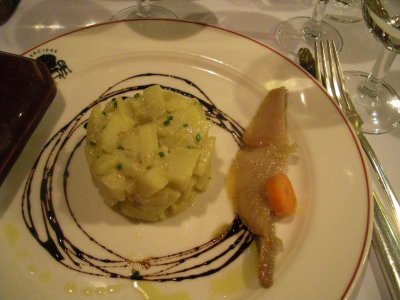 First course, me: Chive potato salad with a "saladier" (salad bowl) of marinated herring. I pictured that as potato salad accompanied by an assortment of kinds of herring. Instead, they brought me a plate drizzled with balsamic syrup and bearing a cylinder of plain potato salad. They they plunked on the table this large crock of house-marinated herring, with two large serving spoons so that I could help myself to as much as I wanted! You can see different corners of the crock's lid in the two photos. I wound up eating two filets of the size you see on my plate, plus a small broken-off piece to go with the last few potato chunks. Delicious.
First course, me: Chive potato salad with a "saladier" (salad bowl) of marinated herring. I pictured that as potato salad accompanied by an assortment of kinds of herring. Instead, they brought me a plate drizzled with balsamic syrup and bearing a cylinder of plain potato salad. They they plunked on the table this large crock of house-marinated herring, with two large serving spoons so that I could help myself to as much as I wanted! You can see different corners of the crock's lid in the two photos. I wound up eating two filets of the size you see on my plate, plus a small broken-off piece to go with the last few potato chunks. Delicious.
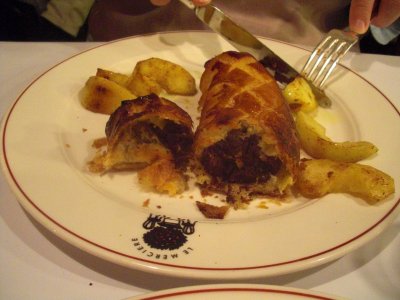
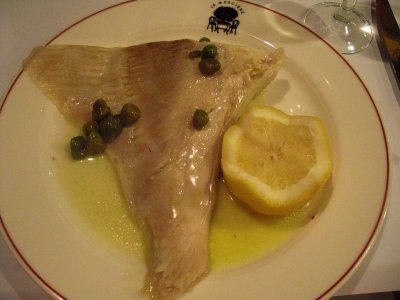 Main course, David: Boudin noir en croute. I couldn't believe that David ordered boudin noir (i.e., black pudding, blood sausage), and I really couldn't believe he ate (and enjoyed) the whole thing! He's come a long way, and it was a particularly mild boudin noir. The items around it on the plate are sautéed apples.
Main course, David: Boudin noir en croute. I couldn't believe that David ordered boudin noir (i.e., black pudding, blood sausage), and I really couldn't believe he ate (and enjoyed) the whole thing! He's come a long way, and it was a particularly mild boudin noir. The items around it on the plate are sautéed apples.
Main course, me: Aile de raie au beurre blond, i.e., skate's wing with butter and capers. It was good, but it needed more butter and more capers, and in any case, I still prefer it "au beurre noir" (i.e., with browned butter). If the prospect of fish served on the bone bothers you, don't be put off by skate's wing—the bones are thick, blunt, and firmly attached to one another (and not to the flesh), so it's the easiest of bone-in fish to eat.
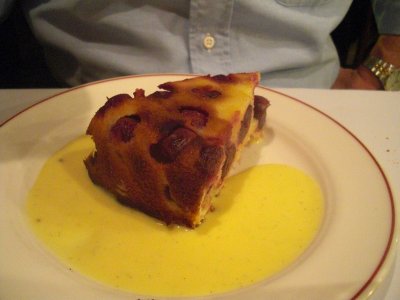
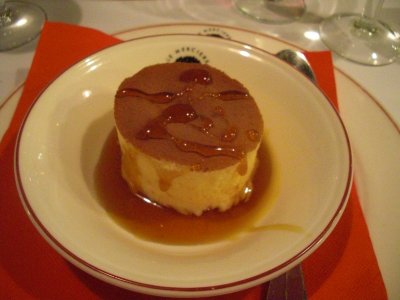 Dessert, David: Clafouti aux cerises, i.e., whole sweet black cherries (with the pits) covered with a thick layer of slightly cakey custard and baked, then served at room temperature with a little boiled custard sauce. He's not usually a fan of sweet cherries but declared it delicious,
Dessert, David: Clafouti aux cerises, i.e., whole sweet black cherries (with the pits) covered with a thick layer of slightly cakey custard and baked, then served at room temperature with a little boiled custard sauce. He's not usually a fan of sweet cherries but declared it delicious,
Dessert, me: Frozen souflée of Grand Marnier with orange caramel syrup. Wow. It was spectacular. I should have offered David a taste and paid closer attention to savoring it, but by that time we were deep in conversation with the Australians at the next table, and it was so good, I wound up just scarfing it down.
Had a pleasant walk home down the west bank of the Saône and over the footbridge at the level of our street.
previous entry
List of Entries
next entry
 We walked back down rue Victor Hugo, a major pedestrian shopping street, toward our hotel, looking for lunch, but surprisingly, restaurants were sparse. It was still very cold and raining, so we finally stopped at a snack bar to get ourselves a couple of hot paninis and chocolate-filled doughtnuts and retired to our room. Here you see them on the table amid our litter of tourist literature , with the rest of my Paris cherries. The breakfast room was standing open, so David was even able to get a cup of hot chocolate. The doughnuts were really good!
We walked back down rue Victor Hugo, a major pedestrian shopping street, toward our hotel, looking for lunch, but surprisingly, restaurants were sparse. It was still very cold and raining, so we finally stopped at a snack bar to get ourselves a couple of hot paninis and chocolate-filled doughtnuts and retired to our room. Here you see them on the table amid our litter of tourist literature , with the rest of my Paris cherries. The breakfast room was standing open, so David was even able to get a cup of hot chocolate. The doughnuts were really good!
 In the time just before and after the birth of Christ, Lyon (called Lugdunum) was the principal city of all of Gaul, with life closely modeled on that in Rome. The emperor Claude was actually borne here, because his father was a local dignitary in the Roman government. Romans, being Romans, always centered their settlements on the highest spot around, so they built the forum on top of the steep hill west of the Saône, now called "Fourvière" (from "forum vertus") (on the site now occupied by this ornate and stylistically eclectic basilica), then spread their improvements, dependencies, etc. around it down the sides of the hill. After the Roman era, though, the Lyonnais (in the late Middle Ages and early Renaissance) were river merchants, so they built right down on the banks of the Saône, on the very narrow strip of land between the water and the steep sides of the "Fourvière." Because river frontage was so valuable, the lots tended to be narrow and deep, so they built their storage buildings, gardens, etc. up the sides of the hill behind their houses. As a result, the official old city, for restoration and preservation purposes, is only three streets deep (measuring from the river) and a dozen blocks long. Space was at a premium because the town was very prosperous (the population was higher than it is today), so second and third houses were built in back yards, progressively up the hill, each several stories high. Exterior tower staircases were built that served more than one house—one directly and the other by means of an open gallery on each floor. Because of the tight packing and steep terrain, many buildings were connected to courtyards or the street by increasingly long, irregular, and twisting interior passages, some with stairs of their own, as they changed levels. Some connect street to street through rows of buildings. These passages are called "traboules" (from "transambulare," to walk through) and are still in use today. The Lyonnais have coined a verb "trabouler," to go someplace through a traboule.
In the time just before and after the birth of Christ, Lyon (called Lugdunum) was the principal city of all of Gaul, with life closely modeled on that in Rome. The emperor Claude was actually borne here, because his father was a local dignitary in the Roman government. Romans, being Romans, always centered their settlements on the highest spot around, so they built the forum on top of the steep hill west of the Saône, now called "Fourvière" (from "forum vertus") (on the site now occupied by this ornate and stylistically eclectic basilica), then spread their improvements, dependencies, etc. around it down the sides of the hill. After the Roman era, though, the Lyonnais (in the late Middle Ages and early Renaissance) were river merchants, so they built right down on the banks of the Saône, on the very narrow strip of land between the water and the steep sides of the "Fourvière." Because river frontage was so valuable, the lots tended to be narrow and deep, so they built their storage buildings, gardens, etc. up the sides of the hill behind their houses. As a result, the official old city, for restoration and preservation purposes, is only three streets deep (measuring from the river) and a dozen blocks long. Space was at a premium because the town was very prosperous (the population was higher than it is today), so second and third houses were built in back yards, progressively up the hill, each several stories high. Exterior tower staircases were built that served more than one house—one directly and the other by means of an open gallery on each floor. Because of the tight packing and steep terrain, many buildings were connected to courtyards or the street by increasingly long, irregular, and twisting interior passages, some with stairs of their own, as they changed levels. Some connect street to street through rows of buildings. These passages are called "traboules" (from "transambulare," to walk through) and are still in use today. The Lyonnais have coined a verb "trabouler," to go someplace through a traboule. Our excellent guide (shown above in the red coat) emphasized that traboules are not public passageways; they are private and belong to the building owner or owners, so unless you live on one or know somebody, or the owner has an agreement with the city to keep one open for passage during the day, you wouldn't ordinarily use them, but the city guides have permission to take groups through, so we saw quite a lot of them, both in the old town and the following day on our tour of the Croix Rousse district. They were useful during the city's heyday as a silkweaving center (for getting bolts of silk from one building to another on rainy days), and they did yeoman service during WWII, when the resistance used them to move around the city unseen. Unless you know them very well, they are hard to find and easy to get lost in. Unfortunately, they're also difficult to photograph. In this photo, we're in a small courtyard, which we reached through one traboule and left through another. The risers of the stone treads of this staircase are pierced so that light can penetrate to illuminate the next flight of stairs below, which descend to the cellar. It's a design unique in Lyon and possibly everywhere.
Our excellent guide (shown above in the red coat) emphasized that traboules are not public passageways; they are private and belong to the building owner or owners, so unless you live on one or know somebody, or the owner has an agreement with the city to keep one open for passage during the day, you wouldn't ordinarily use them, but the city guides have permission to take groups through, so we saw quite a lot of them, both in the old town and the following day on our tour of the Croix Rousse district. They were useful during the city's heyday as a silkweaving center (for getting bolts of silk from one building to another on rainy days), and they did yeoman service during WWII, when the resistance used them to move around the city unseen. Unless you know them very well, they are hard to find and easy to get lost in. Unfortunately, they're also difficult to photograph. In this photo, we're in a small courtyard, which we reached through one traboule and left through another. The risers of the stone treads of this staircase are pierced so that light can penetrate to illuminate the next flight of stairs below, which descend to the cellar. It's a design unique in Lyon and possibly everywhere.
 Here are a couple of the larger and better preserved staircase towers. Both are taller than necessary to house the staircases—a sign of wealth and prestige. The one on the right is the "tour rose," the tallest in the old town; that's its original color. Because the whole district is a national historical monument and world heritage site, restrictions on changing anything are very tight. The mullioned windows are a mark of renaissance architecture. The window frames are stone, but of a color that I keep mistaking for wood.
Here are a couple of the larger and better preserved staircase towers. Both are taller than necessary to house the staircases—a sign of wealth and prestige. The one on the right is the "tour rose," the tallest in the old town; that's its original color. Because the whole district is a national historical monument and world heritage site, restrictions on changing anything are very tight. The mullioned windows are a mark of renaissance architecture. The window frames are stone, but of a color that I keep mistaking for wood.
 First, the bronze cock on the very top raises his head, flaps his wings, and crows twice (he sounds like a french horn). Twenty seconds later, the angel on the nearest corner (just above the level with the clock faces, begins turning this way and that and playing music (sounds like a celesta). A door opens next to the virgin Mary (on the highest light-colored level, below the dark-colored ones) and an archangel (Gabriel, I think) emerges. Then a little drap door over Mary's head opens, a tiny dove descends for a moment, then snaps back up into his cubby. Gabriel retires behind his door, and a priest, leaning out from the level just above Mary, waves his hand to bless her three times. Then the musical angel stops playing, the clock strikes the hour, and that's it until the next show. To conserve the mechanism, its keepers have set it to do the routine only four times a day rather than every hour.
First, the bronze cock on the very top raises his head, flaps his wings, and crows twice (he sounds like a french horn). Twenty seconds later, the angel on the nearest corner (just above the level with the clock faces, begins turning this way and that and playing music (sounds like a celesta). A door opens next to the virgin Mary (on the highest light-colored level, below the dark-colored ones) and an archangel (Gabriel, I think) emerges. Then a little drap door over Mary's head opens, a tiny dove descends for a moment, then snaps back up into his cubby. Gabriel retires behind his door, and a priest, leaning out from the level just above Mary, waves his hand to bless her three times. Then the musical angel stops playing, the clock strikes the hour, and that's it until the next show. To conserve the mechanism, its keepers have set it to do the routine only four times a day rather than every hour. More interesting than the puppet show, though, is the the actual clock. The face shown here is the calendar. It tells the day, day of the week, month, and year (and yes, it knows all about leap years). The tall rectangular panel at the top of the photo lists the principal religious holidays and what day they fall on during the current year. The mechanism soldiers on indefinately, but the white dial with all the numbers and notations on it must be replaced every so often (some odd number of years; 59 maybe? you can figure it out by counting the number of entries in any given ring, toward the center of the dial) Anyway, this is the same dial that was in place when we visited in 1991, which has since rotated around to about the 4 o'clock position. It will have to be changed out for a new one in 2019. Other dials above and below this one and on other faces of the clock tell the phase of the moon, the zodiac sign, the hour, and the minutes.
More interesting than the puppet show, though, is the the actual clock. The face shown here is the calendar. It tells the day, day of the week, month, and year (and yes, it knows all about leap years). The tall rectangular panel at the top of the photo lists the principal religious holidays and what day they fall on during the current year. The mechanism soldiers on indefinately, but the white dial with all the numbers and notations on it must be replaced every so often (some odd number of years; 59 maybe? you can figure it out by counting the number of entries in any given ring, toward the center of the dial) Anyway, this is the same dial that was in place when we visited in 1991, which has since rotated around to about the 4 o'clock position. It will have to be changed out for a new one in 2019. Other dials above and below this one and on other faces of the clock tell the phase of the moon, the zodiac sign, the hour, and the minutes.
 Amuse-bouche, both: Little round dishes of four Lyonnais specialties, clockwise from the top: rich, moist, coarse country-style pâpé; potato salad made with lots of coarse-grainedmustard and bits of soft garlic sausage; a salad of white beans with shallots; and lentils vinaigrette.
Amuse-bouche, both: Little round dishes of four Lyonnais specialties, clockwise from the top: rich, moist, coarse country-style pâpé; potato salad made with lots of coarse-grainedmustard and bits of soft garlic sausage; a salad of white beans with shallots; and lentils vinaigrette.
 First course, me: Chive potato salad with a "saladier" (salad bowl) of marinated herring. I pictured that as potato salad accompanied by an assortment of kinds of herring. Instead, they brought me a plate drizzled with balsamic syrup and bearing a cylinder of plain potato salad. They they plunked on the table this large crock of house-marinated herring, with two large serving spoons so that I could help myself to as much as I wanted! You can see different corners of the crock's lid in the two photos. I wound up eating two filets of the size you see on my plate, plus a small broken-off piece to go with the last few potato chunks. Delicious.
First course, me: Chive potato salad with a "saladier" (salad bowl) of marinated herring. I pictured that as potato salad accompanied by an assortment of kinds of herring. Instead, they brought me a plate drizzled with balsamic syrup and bearing a cylinder of plain potato salad. They they plunked on the table this large crock of house-marinated herring, with two large serving spoons so that I could help myself to as much as I wanted! You can see different corners of the crock's lid in the two photos. I wound up eating two filets of the size you see on my plate, plus a small broken-off piece to go with the last few potato chunks. Delicious.
 Main course, David: Boudin noir en croute. I couldn't believe that David ordered boudin noir (i.e., black pudding, blood sausage), and I really couldn't believe he ate (and enjoyed) the whole thing! He's come a long way, and it was a particularly mild boudin noir. The items around it on the plate are sautéed apples.
Main course, David: Boudin noir en croute. I couldn't believe that David ordered boudin noir (i.e., black pudding, blood sausage), and I really couldn't believe he ate (and enjoyed) the whole thing! He's come a long way, and it was a particularly mild boudin noir. The items around it on the plate are sautéed apples.
 Dessert, David: Clafouti aux cerises, i.e., whole sweet black cherries (with the pits) covered with a thick layer of slightly cakey custard and baked, then served at room temperature with a little boiled custard sauce. He's not usually a fan of sweet cherries but declared it delicious,
Dessert, David: Clafouti aux cerises, i.e., whole sweet black cherries (with the pits) covered with a thick layer of slightly cakey custard and baked, then served at room temperature with a little boiled custard sauce. He's not usually a fan of sweet cherries but declared it delicious,